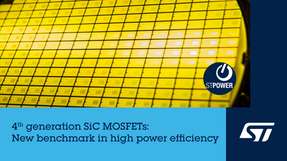Every year power semiconductors worth 40 billion US dollar find their way into power electronics systems and subsystems. The high level of dynamics of power electronics as key enabler for new functions and increasing added value in numerous technical segments raises high expectations for considerable market growth. Prevailing drivers are the increasing demands for energy efficiency and power management, improved reliability and the propagation of electrical and electronic solutions for example in mobile communications and automotive applications. Silicon power semiconductors satisfy the demands of most applications and boast further potential for optimization, especially from the cost perspective. They still cover more than 90 per cent of the market. But new „wide bandgap“ materials such as SiC (silicon carbide) and GaN (gallium nitride) exploit new approaches to foreseeable power problems. Wide bandgap materials enable new systems architectures. For instance the combination of novel topologies with SiC switches increased the efficiency of applications e.g. in the solar industry close to 100 per cent.
Not fully established yet
In SiC technology various components - MOSFETs, JFETs, BJTs, IGBTs and power modules - from different suppliers have already entered the market. But this segment is still some way off from being established - one of the most promising suppliers, SemiSouth, closed its doors last October. However with Cree, Fairchild,Infineon, Rohm, and most of the prominent power electronics players like Fuji,Fujitsu, Mitsubishi, Shindengen, ST Microelectronics, Toshiba or United SiCthe market will show persistent growth. But Philippe Roussel from French market research company YoleDéveloppementanalyzes: „Unless SiC will be implemented in future electric and hybrid vehicles the SiC market size will be limited.“ Lastly it doesn´t come down to the question, who presently stays a nose ahead - SiC or GaN -, but which technology reaches market maturity most rapidly and brings the intended advantages for the targeted applications.Meanwhile GaN is on the verge of becoming successful as technology for electronic components. Presently this very promising material is already implemented in LEDs for lighting, but its outstanding capabilities suggest its use in power semiconductors. There are especially two companies - International Rectifier and EPC - that have invested into GaN product research in recent years. Following YoleDéveloppement the GaN market will take up speed in this year, with 50 million dollar sales, which will then rise to 350 million until 2015 and above 1 billion until 2021.
High potential savings
The advantages of GaN are a higher switching frequency, lower recovery charge and a higher permissible junction temperature, leading to potential savings of more than 50 per cent. Economy of GaN switches up to 600V is double that of SiC switches, but this is still much more expensive thantraditional silicon solutions. Experts predict that a GaNMOSFET will have reached the level of a silicon model in around five years, as it can take advantage of almost the same production devices as a Si MOSFET. Highly efficient low-loss components in photovoltaicsystems, computer power supplies, mobile communications or power electronics for electric and hybrid cars increasingly bank on the new material. Power converters needed in electric vehicles play an evermore important role. Their efficiency and their power density are essential factors for the success of nearly all green-car concepts for future e-mobiles.
Advantage in high frequency
Similarly semiconductors are decisive for efficient amplification and fast transmission of information in mobile radio of the future. For instance the cellular network in Germany consumes as much electrical energy as a medium-sized power plant can produce. Base stations account for around 80 per cent of this energy, above all for amplification and cooling. Replacing Si by GaN components, energy consumption could be reduced to about a quarter. Moreover the GaN amplifier brings additional advantages in the high frequency domain.The problem: Such powerful and highly efficient devices need large GaN monocrystals with a crystal structure as error-free as possible which cannot be produced with classical melt breeding. GaN must be grown out of the gas phase or a gallium- or nitrogen-rich solution. These processes are slow, very complex and costly, and the final GaN yield is limited. The emerging crystals weigh only a few hundred grams - so the „magic material“ is still extremely expensive. In terms of weight a GaN substrate with two inch diameter is almost ten times as expensive as gold!That isn´t a problem for lighting applications, as LEDs need less power, and the crystals are allowed to be defective. In this case GaN is just an ultra-thin crystalline layer on a sapphire or silicon substrate. The big chemical and physical differences between layer and substrate cause numerous crystal lattice defects - but the LEDs function even with more than a billion defects per square centimeter.
Reaching higher efficiency
In contrary with just one thousand defects on the same space in the active layer the power electronics devices will benoticeably less powerful and reliable. For highly efficient devices the deposition of the active layers on defect-free large single-crystal GaN substrates is very complex and costly. Since end 2011 scientists of Fraunhofer InstitutesTHM and IISB together with experts from Freiberger Compound Materials carry on research to decisively improve an existing production process for GaN crystals: The hybrid vapor phase epitaxial process (HVPE) based on initially gaseous hydrogen chloride combines with liquid gallium at around 880°C to gaseous gallium chloride. This is transported to a gallium nitride crystal core at between 1000 and 1100°C; simultaneously ammonia flows in which combines with the gallium chloride to crystalline gallium nitride. In optimum conditions the crystal achieves five centimeters in diameter,a few millimeters thick. This process is still in its development, but materials development takes time - for SiC it took more than ten years to increase the crystal to 3 inch diameter the thickness of a finger. The scientists intend to distinctly increase the material efficiency within three years thus contributing that GaN will become considerably cheaper than gold.
















